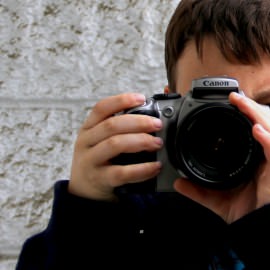 Instead of the advice of photography professionals, instructors and experts, (who are excellent sources of information), Panasonic decided to ask a large sample of beginner and amateur photographers what mistakes they make most often. The findings create an instructive checklist you can use to highlight the mistakes you make. Once you’ve evaluated yourself against the survey participants, you’ll then have a nice action plan of photography techniques you know need improvement. Focus on these to learn and practice.
Instead of the advice of photography professionals, instructors and experts, (who are excellent sources of information), Panasonic decided to ask a large sample of beginner and amateur photographers what mistakes they make most often. The findings create an instructive checklist you can use to highlight the mistakes you make. Once you’ve evaluated yourself against the survey participants, you’ll then have a nice action plan of photography techniques you know need improvement. Focus on these to learn and practice.
-
Panasonic’s survey found that 35.2% of respondents said they have forgotten to check their camera’s batteries frequently, and experienced a loss of power. Battery capacity, as measured in the number of frames either as RAW or JPEG files, is an important specification to consider when buying a digital camera. If you don’t know the limit of your camera’s batteries, then here is another good reason to read your manual.
-
Of all survey participants, 29.3% found that their biggest problem was learning how to hold the camera steady, which resulted in many blurry images. Even if you’re buying an inexpensive compact camera, you should hold one in your hands before spending your money. It’s important it feels comfortable in your hands, not a test subject’s in the manufacturer’s lab. You also want to investigate carefully how the manufacturer has designed a camera, so it can be held very steady. Typically, the more expensive the camera, the better the ergonomics and how easy it is to hold steady. Regardless of the quality of the equipment, handholding a camera and producing sharp images is a technique to learn and practice.
-
The survey discovered that 22.7% of photographers had blurry subjects in their photos because the shutter speed was too slow. Cameras with automatic exposure control, typically compacts, won’t usually cause this problem. If the auto mode does, then learn how to set the exposure manually, if your camera allows it, and try photographing that moving subject again.
-
The next largest group of photographers “confessed” that they forgot to compensate for shutter, or time, lag. This is the brief gap of time between when you push the shutter release and before your camera actually registers the image. Point-and-shoot cameras usually have a longer shutter lag than a DSLR camera.
-
It’s no surprise that lack of focus is near the top of the list. Approximately 17% of survey respondents said many of their photos had the background in focus, but not the subject. Placing the focus point on the background causes this mistake.
-
Underexposure was the sixth most common beginner and amateur photography mistake, at 19.3%. Again, the auto mode of many cameras will compensate for low light, so the image isn’t underexposed; however, if you start to push the auto mode’s limit, it may produce an underexposed image.
-
Similar to the battery mistake above, 16.5% of photographers allowed their memory to fill, and suddenly had no space for the image they just tried to capture. Probably, the best way to avoid this mistake is to read your manual and drill the specs into your head just as you did the multiplication tables as a child.
-
It’s a good bet that the 12.2% who said their biggest mistake was overexposure were also among the photographers who had overexposed photos. Avoiding over (and under) exposures comes with practice and experience as you learn in what kind of light conditions they can occur.
-
Although white balance is near the bottom of the list, you may be like the 6.8% that make this mistake. An incorrect white balance setting can cause your photos to be lightly saturated with an orange, blue or yellow tinge. There is nothing particularly difficult about learning how to set your camera’s white balance correctly. The tricky part, however, is your eyes adjust so quickly to the various photographic light sources (sunlight, flash, studio, etc.) you don’t see those traces of color when you are looking through the viewfinder. Again, it’s the limitation of your camera’s automatic white balance mode. It will serve you well most of the time, but you’ll be confronted with shooting challenges that requires you know how to set it manually.
-
Only 10% of photographers surveyed admitted to incorrect pixel settings. This number is likely to be low because most cameras come from the manufacturer preset at a medium pixel count and that works for the kind of photos most people shoot. Nonetheless, it is a camera setting you should understand thoroughly, so you know how to change it for specific situations.
-
Shutter speed generated 5.4% of the responses, which makes sense if photographers were producing overexposed and underexposed images.
-
ISO, as one of the three elements of the exposure formula, is a common mistake for only 3.7% of photographers. Again, the photos of most photographers are within the broad ISO ranges of most cameras; but ISO is an important concept and feature you should study and know to adjust.
Photo copyright PhotographyTalk member Sheila
Your feedback is important to thousands of PhotographyTalk.com fans and us. If this article is helpful, then please click the Like and Re-Tweet buttons at the top left of this article.
